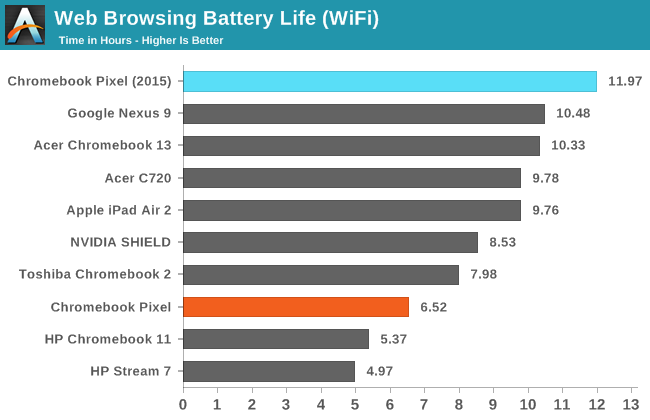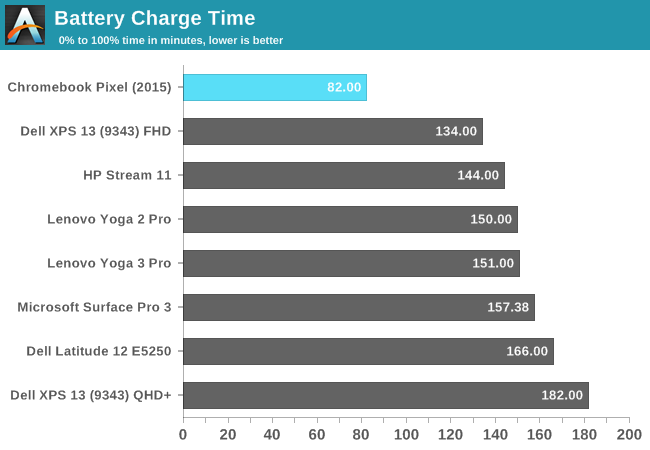The Chromebook Pixel (2015) Review
by Brandon Chester on March 16, 2015 8:00 AM EST- Posted in
- Laptops
- Chrome OS
- Chromebook
- Chromebook Pixel
Battery Life
One area where Google claims to have made large improvements over the original Pixel is battery life. The 2013 version of the Pixel would typically manage six or seven hours of battery life, which was decent but not outstanding at the time. Given that the Pixel did not run much more than a web browser, it was actually somewhat disappointing to see it falling behind other laptops like the 13" MacBook Pro with Retina display which was substantially more powerful and capable. Google claims that the new Chromebook Pixel will achieve up to twelve hours of battery life, which is quite a lofty goal considering it is around twice the battery life of the original. Given that the new Pixel has the same 59 Wh battery as its predecessor, all of the battery life improvements have to come from reduced component power usage and software optimizations.
The two main areas where power usage has been reduced are the CPU and the display. The CPU is one of Intel's new Broadwell-U processors, built on their 14nm manufacturing process. While it is faster than the Ivy Bridge Core i5 used in the original Pixel, it has significantly reduced power usage due to architectural improvements and the move from a 22nm to a 14nm fabrication process. The display is similar to the original, but Google is now using Content Adaptive Backlight Control (CABC) to manage backlight brightness based on the display's Average Picture Level (APL), as well as Panel Self Refresh (PSR). It should be noted that although PSR is a display feature, it's actually a method of reducing CPU/GPU and display bus power usage, not LCD panel power usage.
To see if Google achieved their goal of a twelve hour battery life, I have run the Pixel through our standard web browsing test as well as our H.264 video playback test.


In our WiFi web browsing test, the Pixel is only two minutes short of Google's up to twelve hours rating, and with that battery life it sits well above all the other tablets and Chromebooks. In our video playback test it still performs very well with 9.77 hours, but it doesn't end up lasting quite as long as some of the most recent tablets. Regardless, the battery life in both scenarios is an absolutely massive improvement over the original Pixel, with almost two times the battery life during web browsing and over three times the battery life when playing back videos.
Charge Time
As mentioned earlier, the new Chromebook Pixel uses USB Type-C for charging. Since the Pixel has a Type-C port on each side, you can charge it from both the left and the right. While this doesn't sound like a big deal, it can be the difference between charging and not charging in situations where you're far from an outlet. It is also just a great connector in general, and the fact that it is just USB means that you can use a USB Type-A to Type-C cable to charge off of any existing USB port, with the caveat that it's going to charge slower. Google includes a 60W USB Type-C charger with the Pixel, and offers a Type-A to Type-C cable for $12.99.

The Pixel does exceptionally well in our charge time test, reaching a full charge nearly an hour quicker than the XPS 13 which was previously the quickest to charge. The quick charging combined with the extremely long battery life should ensure that Pixel users are never stuck tethered to a power outlet.










123 Comments
View All Comments
jimbo2779 - Tuesday, March 17, 2015 - link
You cannot ski 24/7, also kids tend to enjoy watching things they like while their parents sit around and have a relaxing drink.Face it 32GB is a tiny amount, especially when you are splashing this much cash for a laptop, it is absolutely inexcusable. There are so many scenarios where you would want some media on the machine and you would easily fill this up. Having to lug around extra USB drives to ensure you have enough storage when away from a net connection is just not as convenient.
Relying on cloud or NAS for your media is fine if you never leave your home or office but when you are out and about you need LTE for full coverage and not only does this cost more you are not always covered when not in a city and coverage can be spotty when you do have it.
On top of this there is the argument of relying on cloud storage which is great until they start charging for it after a few years so something that could have been added in the high price of your laptop is now costing real money.
Again, 32Gb at this price point is inexcusable, there are many reasons as to why.
armwood - Sunday, September 20, 2015 - link
It seems that so many people do not understand the concept of the Chrome operating system. It is a cloud system. Wifi is most places and where it is not either carry a hotspot or tether your phone. It is not rocket science. Google Drive or Dropbox can whole all of your data with movies etc on an SD card. Wake up, this is the future of computing. It amazes me how shortsighted so many people are.armwood - Sunday, September 20, 2015 - link
You need to spend a fee days with a Chromebook Pixel 2 LS. I use it and leave my Macbook Pro and Surface Pro 3 on my desk. I take it and use it for my college lectures over the other two machines. It is a superb, fast device that works in environments with weaker wifi signals better than Apple or Windows computers.jabber - Wednesday, March 18, 2015 - link
I've been using my Chrombook for over 2 years now. No user data has ever touched the 16GB SSD in it in all that time.I don't get the love for 'big data'. Just seems like tying yourself down to a huge anchor.
armwood - Sunday, September 20, 2015 - link
It seems that so many people do not understand the concept of the Chrome operating system. It is a cloud system. Wifi is most places and where it is not either carry a hotspot or tether your phone. It is not rocket science. Google Drive or Dropbox can whole all of your data with movies etc on an SD card. Wake up, this is the future of computing. It amazes me how shortsighted so many people are.psychobriggsy - Monday, March 16, 2015 - link
There's a lot to like about this product - especially the hardware and design.If it came with a 256GB SSD with Crouton pre-installed, that would have been great. 32/64GB isn't enough so you'd need to spend more on replacing this - a build option would be great. Yeah, I know this doesn't fit into Google's concept of a computing device.
The touchscreen is a bit pointless, unless they had made the device more Yoga-like, with a tablet folding mode.
In terms of hardware design, this is up there with the best. Other OEMs can learn a lot from this, for their non-Air-ripoff designs.
Hanoveur - Monday, March 16, 2015 - link
You can buy a 256gb XDSC card and plug that into it.jimbo2779 - Tuesday, March 17, 2015 - link
And spend more money fixing something that should not be an issue, sounds like a great solution.Also it is easy to lose a memory card, especially when kids are around. Built in storage is slightly harder to lose
steven75 - Wednesday, March 18, 2015 - link
Did you just bring up Flash player in 2015?djw39 - Monday, March 16, 2015 - link
But that "real computer" can be old and cheap. For example, I have a desktop PC I got 10 years ago for $500, anything the chromebook can't do due to limitations of the OS can theoretically be done on the desktop. In real life I almost never use the desktop.Now, I fully admit, I'd take an orange-and-white plastic version for $500-600. But I think a high-resolution screen and Core i5 sounds about right for the hardware.